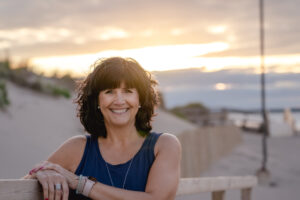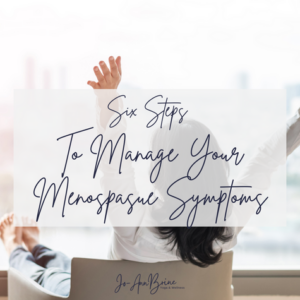
by Jo-Ann Brine | Menopause, Menopause, Midlife, Perimenopause |
Midlife can feel like a wake-up call. One minute you’re juggling work, family, and life like a pro, and the next, you’re wondering why your joints ache, your energy has dipped, and your body isn’t bouncing back like it used to.
But here’s the good news: midlife is the perfect time to invest in longevity—not just to live longer but to live stronger, healthier, and more vibrant into your 40s and beyond.
In this blog, we’ll cover exactly how to build longevity habits in your 40s, 50s, and 60s—without overhauling your entire life.
What Happens After Age 40?

Let’s start with the question many midlife women are asking: What really happens after age 40?
As we age, a few key changes begin to impact our health:
- Muscle mass starts to decline—up to 8% per decade after 40.
- Hormonal shifts, particularly around perimenopause and menopause, affect energy, mood, and metabolism.
- Bone density decreases, increasing the risk of fractures.
- Cognitive function may begin to decline slowly.
- And let’s not forget the stress, sleep disruptions, and weight gain that often creep in too.
These changes aren’t a reason to panic—they’re a reminder to get proactive. The choices you make today can have a powerful impact on your longevity tomorrow.
What Are the Biggest Midlife Health Risks?
 Understanding your risks is the first step to creating a solid longevity plan. The top health risks for women in midlife include:
Understanding your risks is the first step to creating a solid longevity plan. The top health risks for women in midlife include:
- Heart disease (the #1 killer of women)
- Type 2 diabetes
- Osteoporosis
- Cognitive decline (including Alzheimer’s)
- Obesity
- Chronic stress and depression
Many of these conditions are preventable—or at least manageable—with simple, sustainable lifestyle changes.
Midlife Longevity Habits That Make a Difference
 So what can you do now to set yourself up for a long, vibrant life? These five longevity habits are powerful tools for thriving in midlife and beyond.
So what can you do now to set yourself up for a long, vibrant life? These five longevity habits are powerful tools for thriving in midlife and beyond.
1. Move Your Body with Purpose
Regular movement is one of the best longevity tools we have. And no—you don’t have to run marathons or join CrossFit.

Focus on these three types of movement:
- Strength training 2–3 times per week to protect muscles and bones
- Daily walking to support cardiovascular health and mood
- Flexibility and balance training, like yoga or mobility work, to stay agile and prevent falls
Longevity Tip: Don’t aim for perfection—just aim to move more than you sit.
2. Prioritize Protein and Whole Foods

Nutrition doesn’t have to be complicated. Focus on:
- Plenty of lean protein to support muscle retention
- Colourful vegetables and fruits for fiber and antioxidants
- Healthy fats like olive oil, avocado, and nuts
- Whole grains for energy and heart health
Cut back on ultra-processed foods, added sugars, and anything that makes you feel bloated, sluggish, or foggy.
Longevity Tip: Eating for longevity isn’t about dieting—it’s about fueling your body for energy, strength, and healing.
3. Sleep Like It’s Your Job
Midlife sleep struggles are real, thanks to hormonal shifts, stress, and busy schedules. But sleep is non-negotiable for brain health, metabolism, and mood.

Try:
- A consistent sleep-wake schedule
- Limiting screen time 1 hour before bed
- Cooling down your bedroom
- Evening rituals like journaling or restorative yoga
Longevity Tip: Treat bedtime like a sacred ritual—not a last-minute afterthought.
4. Manage Stress Like a Pro
Midlife often brings more stress—aging parents, work changes, family demands. Chronic stress, however, accelerates aging at the cellular level.

Support your longevity by:
- Practicing daily breathwork or meditation
- Creating “white space” in your schedule
- Saying no to things that drain your energy
- Spending time in nature or with loved ones
Longevity Tip: Calm isn’t a luxury—it’s a strategy for long-term health.
5. Build Strong Social and Mental Health
Social isolation and cognitive decline often go hand-in-hand in older adults. But this is preventable!

- Stay socially connected
- Challenge your brain with new skills
- Cultivate joy and purpose (it’s not frivolous—it’s fuel!)
Longevity Tip: Your relationships and mindset may be just as important as your exercise plan.
Longevity Is a Lifestyle, Not a Quick Fix

If you’ve ever started (and stopped) a diet or wellness routine, you’re not alone. But the secret to midlife longevity isn’t in extremes or perfect plans—it’s in small, consistent habits that build over time.
Even just a few changes—walking more, strength training twice a week, adding more protein, going to bed 30 minutes earlier—can help you feel younger, stronger, and more like yourself again.
You’re Not Too Late—and You’re Not Alone
It’s never too late to choose longevity. Every step you take toward health now is a gift to your future self.
Whether you’re feeling tired, stressed, or like you’ve lost your spark, this can be your turning point. Not because you’re trying to be who you used to be—but because you’re becoming who you were always meant to be: strong, energized, and confident in your body and your choices.
You’ve still got decades of life ahead. Let’s make them count.
Ready to Take the First Step Toward a Longer, Stronger Life?
Don’t just read about longevity—start living it today.
Grab the Longevity Starter Kit to learn the exact habits and simple shifts that support energy, strength, and vibrant health in midlife.
👉 Download the Starter Kit here
And don’t do it alone! Join a community of like-minded women in The Midlife Wellness Lounge Facebook Group, where we share tips, encouragement, and real-life strategies for aging well—together.
Your journey to feeling amazing in your 40s, 50s, and beyond starts now.

by Jo-Ann Brine | Menopause, Midlife, Perimenopause, Yoga |
Is exercise really that important for midlife women? Who has time for that??
YES! The answer is a resounding YES!
Exercise is important for people of all ages, but it becomes even more critical for women in midlife. Women in their 40s and 50s may begin to experience a variety of physical and hormonal changes that can negatively impact their health and well-being. Fun, right? It’s not all doom and gloom, though because exercise can help mitigate the results and symptoms that come along with some of these changes and improve overall health. The key is to be doing exercise that works with your body, and not against it.
Let’s dive in!
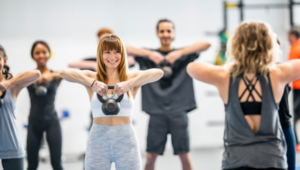
One of the most significant changes women in midlife experience is a decrease in estrogen levels. This decrease can lead to a range of symptoms, including hot flashes, night sweats, and vaginal dryness. And guess what? Exercise can help manage these symptoms!
Midlife women are also at a higher risk for other health conditions, including heart disease, osteoporosis, and type 2 diabetes. Exercise can help reduce the risk of developing these conditions by improving cardiovascular health, increasing bone density, and regulating blood sugar levels.
Regular exercise can also help midlife women maintain a healthy weight. As women age, their metabolism slows down, making it more challenging to maintain a healthy weight.
Good nutrition can help here too, but that’s a topic for another day 😀
Beyond the physical benefits, regular exercise can also improve mental health and cognitive function. Studies have shown that regular exercise can reduce the risk of depression and anxiety, improve memory and concentration, and increase overall cognitive function.
You may be wondering if there are specific exercises that are better for midlife women and the answer is YES!
Here are my suggestions for what to include in your exercise “routine”
Strength/Resistance Training

Strength training is first on my list as it’s the most important and one that we midlife women neglect. We lose muscle mass as we age and we need strength/resistance training to prevent this from happening. Using weights, resistance bands, or bodyweight exercises, can help improve bone density, maintain muscle mass, and boost metabolism. Aim for two full-body strength/resistance sessions per week, targeting major muscle groups like the legs, arms, chest, back, and core.
TIP: Start by doing squats without weights and gradually work up to adding weight or resistance bands. Try push-ups at the wall and as you get stronger, lower the incline to a counter, then to a bench, and finally to the floor.
Cardiovascular Exercise
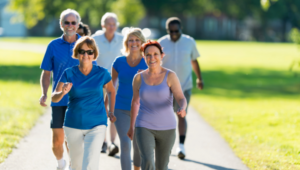
Cardiovascular exercise, such as walking, cycling, swimming, or dancing, can help improve heart health, reduce the risk of chronic diseases, and maintain a healthy weight. Aim for 2 or 3 30-45 minutes sessions of low/moderate-intensity cardio exercise per week. Don’t overdo it here, ladies. Get outside if you can.
TIP: Take short 5-10 minute walk breaks during your day. It all adds up 🙂
Flexibility
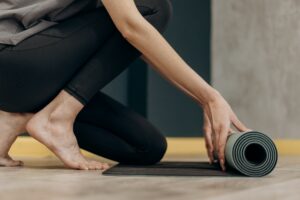
Flexibility exercises like stretching, yoga, pilates, or tai chi can help improve range of motion, reduce the risk of injury, and improve posture. Aim for at least two flexibility sessions per week or better yet, add a daily yoga routine to your repertoire. Short sessions more often can be better than fewer long sessions per week. 10 minutes a day is all you need but be warned, you may want to do more 😉
TIP: If you sit at a desk all day, take regular stretching breaks. Your body will thank you for it.
Mobility

Mobility exercises are essential for midlife women to maintain flexibility, joint health, and overall physical function. As we age, our joints can become stiffer, and our range of motion can decrease. Mobility exercises can help maintain and improve joint health, reduce the risk of injury, and improve posture. Some examples of mobility exercises for midlife women are:
- Shoulder rolls
- Arm circles
- Ankle circles
- Hip circles
- Twists
TIP: Incorporate these moves into a warm-up or cool-down. Many mobility moves will already be included in a yoga class.
Balance

Balance exercises, such as standing on one foot, walking heel to toe, or doing balance poses in yoga, can help reduce the risk of falls and improve overall balance. A bonus of balance work is that it also works the core!
TIP: Try standing on one foot while standing in line at the grocery store. Or do a tree pose and see what kind of looks you get 😜
High-Intensity Interval Training
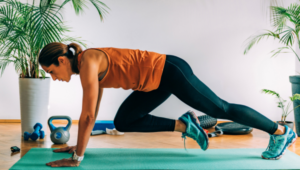
High-Intensity Interval training (HIIT) is a form of exercise that involves short bursts of high-intensity exercise followed by periods of rest. It can help improve cardiovascular health, increase metabolism, and burn calories in a short amount of time. However, it may not be suitable for everyone, especially those with certain health conditions or injuries. Try to keep HIIT to 45 minutes total per week, broken up into a minimum of 2 sessions.
TIP: Don’t complicate it. Make the exercise simple but intense enough to get the heart rate up.
Overall, exercise is essential for midlife women to maintain their health and well-being. Incorporating regular physical activity into their daily routine can help manage symptoms of menopause, reduce the risk of chronic conditions, maintain a healthy weight, and improve mental health and cognitive function. Bonus – Exercise also helps improve sleep when done early in the day…zzzzz!
Need some help getting started?

If you would like some guidance on what to do and how to incorporate more movement into your day, I invite you to check out my upcoming 7-day yoga/movement challenge for midlife women – CLICK HERE

by Jo-Ann Brine | Menopause, Midlife, Perimenopause |
I’m often asked how important exercise and nutrition are with respect to their effects on our “menopausal” symptoms and overall health. The short answer is VERY IMPORTANT…allow me to elaborate.
Here are a few ways exercise can help:
- Reduce hot flashes: Exercise has been shown to reduce the frequency and intensity of hot flashes in menopausal women. Yay!
- Improves bone density: Regular weight-bearing exercise can help maintain and improve bone density, which can decrease the risk of osteoporosis.
- Improves mood and reduces stress and anxiety: Exercise has been shown to improve mood and reduce anxiety in menopausal women.
- Improves cardiovascular health: Exercise can help lower blood pressure, reduce the risk of heart disease, and improve overall cardiovascular health.
It’s important to stay active and engage in regular physical activity, which can help support bone health and maintain muscle mass. Be sure to incorporate strength/resistance training in your exercise plan. Make sure you are doing the right type of exercise as well as the right amount for your midlife body. While we know exercise is good for our health, there is the potential of too much of a good thing, especially when it comes to cardio.
The importance of Nutrition:
- Helps manage weight: Proper nutrition can help women maintain a healthy weight during perimenopause, menopause, and post-menopause.
- Improves bone health: A diet rich in calcium, vitamin D, and other bone-healthy nutrients can help maintain and improve bone density.
- Reduces the risk of chronic diseases: A healthy diet can help reduce the risk of chronic diseases such as heart disease, diabetes, and cancer.
- Reduces hot flashes: Certain foods, such as soy products and flaxseed, may help reduce the frequency and intensity of hot flashes in menopausal women. Yes, please!
Overall, a healthy and balanced diet for perimenopausal women should focus on whole, nutrient-dense foods and limit processed and high-sugar foods.
Here are some guidelines for a healthy and balanced diet for perimenopausal women:
- Eat your veggies…and lots of them! They are rich in vitamins, minerals, and fiber, which can help support overall health and reduce the risk of chronic diseases. Especially leafy greens and cruciferous veggies like broccoli and cauliflower.
- Whole grains: These are a good source of fiber and can help regulate blood sugar levels, which can be important during perimenopause when insulin resistance may be increased.
- Prioritize protein: Protein is important for maintaining muscle mass and supporting bone health, both of which can be affected during perimenopause. Choose lean sources of protein such as poultry, fish, tofu, and legumes. Try to get a serving of protein at each meal.
- Incorporate healthy fats: Omega-3 fatty acids are important for brain health, can help reduce inflammation and improve heart health. Good sources of omega-3s include fatty fish, flaxseeds, chia seeds, and walnuts.
- Incorporate phytoestrogen-rich foods: Phytoestrogens are plant compounds that mimic estrogen in the body. They can help alleviate hot flashes and other menopausal symptoms. Foods rich in phytoestrogens include soybeans, tofu, tempeh, flaxseeds, sesame seeds, and whole grains.
- Avoid processed foods: These often contain high amounts of added sugars, salt, and unhealthy fats, which can increase the risk of chronic diseases and exacerbate symptoms of perimenopause.
- Limit alcohol and caffeine intake: Sorry, ladies…both can disrupt sleep and exacerbate symptoms such as hot flashes and mood changes.
Want more tips and encouragement for managing your menopause symptoms? Download your 6-Step Guide right here!


 Understanding your risks is the first step to creating a solid longevity plan. The top health risks for women in midlife include:
Understanding your risks is the first step to creating a solid longevity plan. The top health risks for women in midlife include: So what can you do now to set yourself up for a long, vibrant life? These five longevity habits are powerful tools for thriving in midlife and beyond.
So what can you do now to set yourself up for a long, vibrant life? These five longevity habits are powerful tools for thriving in midlife and beyond.
















